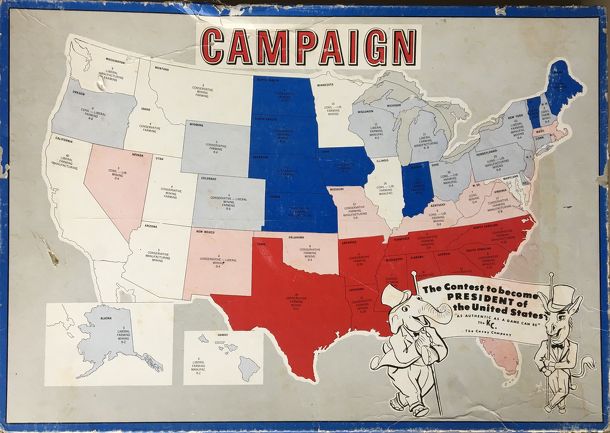Campaign: The Contest to Become President of the United States társasjáték
társasjáték, 1962
A Campaign: The Contest to Become President of the United States egy remek társasjáték, 2 - 4 játékos részére.
Angol:
This very rare 1962 title takes a multi-layered and highly strategic approach to the U.S. election campaign. It is designed for two players or teams. Components include a 4-part...
Angol leírás
This very rare 1962 title takes a multi-layered and highly strategic approach to the U.S. election campaign. It is designed for two players or teams. Components include a 4-part jigsaw-puzzle style board, a deck of weekly Event Cards, a deck of Daily Crisis cards, sets of red and blue counters, a campaign tally sheet, one red and one blue campaign die, a rules book and a summary playing sequence card.
Each state is classified by region, political philosophy (Liberal/Conservative), party preference (Democrat/Republican) and key economic interest (Mining, Manufacturing or Farming). Each party begins by choosing Presidential and VP home states (with local and regional benefits) and political philosophy (Conservative, Liberal or Moderate).
Each campaign week starts with an Event card that combines a random bonus/penalty event with a political statement or proposal. Candidates get penalties and bonuses depending on the stand they support. For instance, supporting a Southern Senator's controversial statement adds 3 regional points in the South but costs 1 in other regions and 2 in each Liberal state; denouncing has an opposite effect.
Each week has six campaign days. On each day, the candidate can make a personal appearance in any one state, adding 5 points in that state, sometimes modified by that day's Crisis card. Each party also has a limited number of media campaigns that can be targeted locally (+8), regionally (+3) or nationally (+1). Point counters are used to show net advantage in each state and in boxes for regions, economic interests, political philosophy and the nation as a whole, while the party advantages in each state are marked on the board.
The game runs for 9 weeks plus the Monday before Election Day. On election day, the result for each state is determined by tallying each party's net advantage in national, regional and local support, economic interest, political philosophy and party advantage, modified by a final -2 to +2 die roll by each party. The party with the highest net wins that state's electoral college votes, and 270 EC votes wins the election. An EC vote tie is broken by number of states won, with the District of Columbia being the final tie-breaker.
Kategória: Politika
Párosan
Már ketten is játszható! Remek kikapcsolódás lehet pároknak is!
Campaign: The Contest to Become President of the United States társasjáték vásárlása, árak és üzletek
Jelenleg egyik üzletben sem kapható a játék! Állíts be egy árufigyelést, hogy értesülj, amikor újra kapható lesz a boltokban!
Kommentek
Részletes adatok
Részletek
- Kiadók: The Casey Company
- Elérhető nyelvek: angol
Kiadások
- First edition
- Kiadás éve: 1962
- Nyelv: angol
- Méretek: 30.5 cm x 43.2 cm x 3.8 cm


